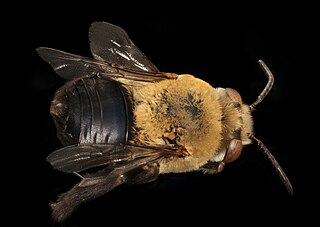
Fire-coloured beetles is the common name for members of the tenebrionoid family Pyrochroidae. The family is found worldwide, and is most diverse at temperate latitudes. Adults measure 2–20 millimetres (0.079–0.787 in); larvae reach 35 millimetres (1.4 in). Larvae of Pyrochroinae are found associated with the bark of dead trees. They are probably mostly fungivorous, although they may become cannibalistic if too crowded.

The Ochteridae comprise a small family of insects. Eight genera with about 80 species have been described. They occur worldwide along the shore of various types of water and the greatest diversity is in tropical regions. They are "true bugs", being members of the order Hemiptera, and are in the suborder Heteroptera. Ochteridae commonly are known as the velvety shore bugs. They resemble the Saldidae shore bugs and have lengths ranging from 4.5 to 9 mm (0.18–0.35 in).

Svastra is a genus of long-horned bees in the family Apidae. There are at least 20 described species in Svastra.
Chasmatonotus atripes is a species of midge in the family Chironomidae.
Chasmatonotus is a genus of midges in the family Chironomidae. There are about 14 described species in Chasmatonotus.
Nannocyrtopogon inyoi is a species of robber flies in the family Asilidae.
Nannocyrtopogon is a genus of robber flies in the family Asilidae. There are at least 20 described species in Nannocyrtopogon.

Odontocolon is a genus of ichneumon wasps in the family Ichneumonidae. There are at least 40 described species in Odontocolon.

Centris atripes is a species of centridine bee in the family Apidae. It is found in Central America and North America. It is a pollinator of Krameria erecta as well as Senna wislizeni of the painteri variety, which it pollinates during the rainy season.

Svastra atripes is a species of long-horned bee in the family Apidae. It is found in North America.
Itolia is a genus of robber flies in the family Asilidae. There are about five described species in Itolia.
Nannocyrtopogon vanduzeei is a species of robber flies in the family Asilidae.
Nannocyrtopogon aristatus is a species of robber flies in the family Asilidae.

Dicosmoecus atripes is a species of northern caddisfly in the family Limnephilidae. It is found in North America.

Dicosmoecus is a genus of october caddis in the family Limnephilidae. There are about six described species in Dicosmoecus.
Mallochohelea atripes is a species of biting midges in the family Ceratopogonidae.

Galerita atripes is a species of ground beetle in the family Carabidae. It is found in North America.
Lestomyia is a genus of robber flies in the family Asilidae. There are about six described species in Lestomyia.

Oedipoda miniata, sometimes known as the red-winged grasshopper, is a grasshopper species in the subfamily Oedipodinae found in Southern Europe, northern Africa and the Middle-East.

Pycnochromis atripes, the dark-fin chromis, is a diurnal species of damselfish belonging to the genus Pycnochromis. It can be found in the Western Pacific Ocean in Christmas Islands and in north-western Australia in the East Indian Ocean to Kiribati, and north to Southern Japan. It can also be found in Tonga. It inhabits areas of outer reef and slopes which are rich in coral, appearing singly or in small groups near the bottom. It is oviparous, and the males of the species guard and aerate the eggs.>










